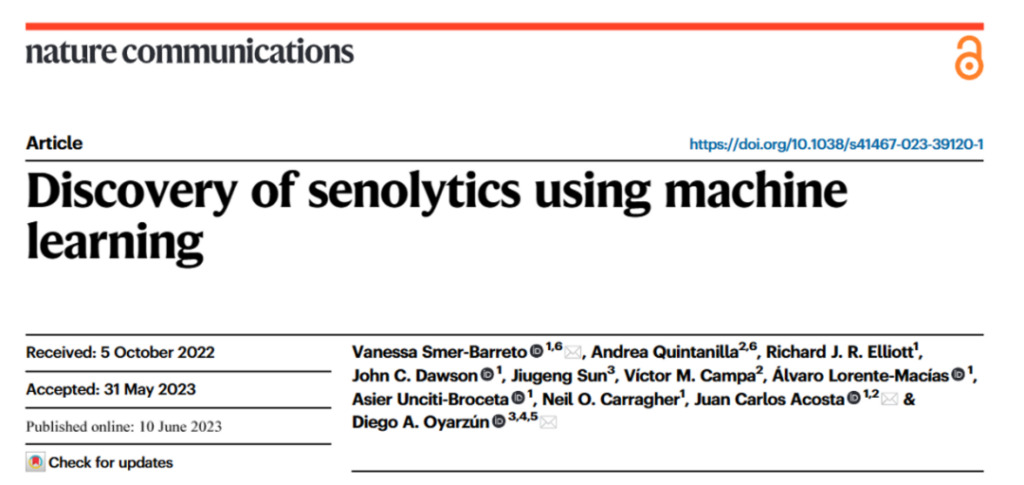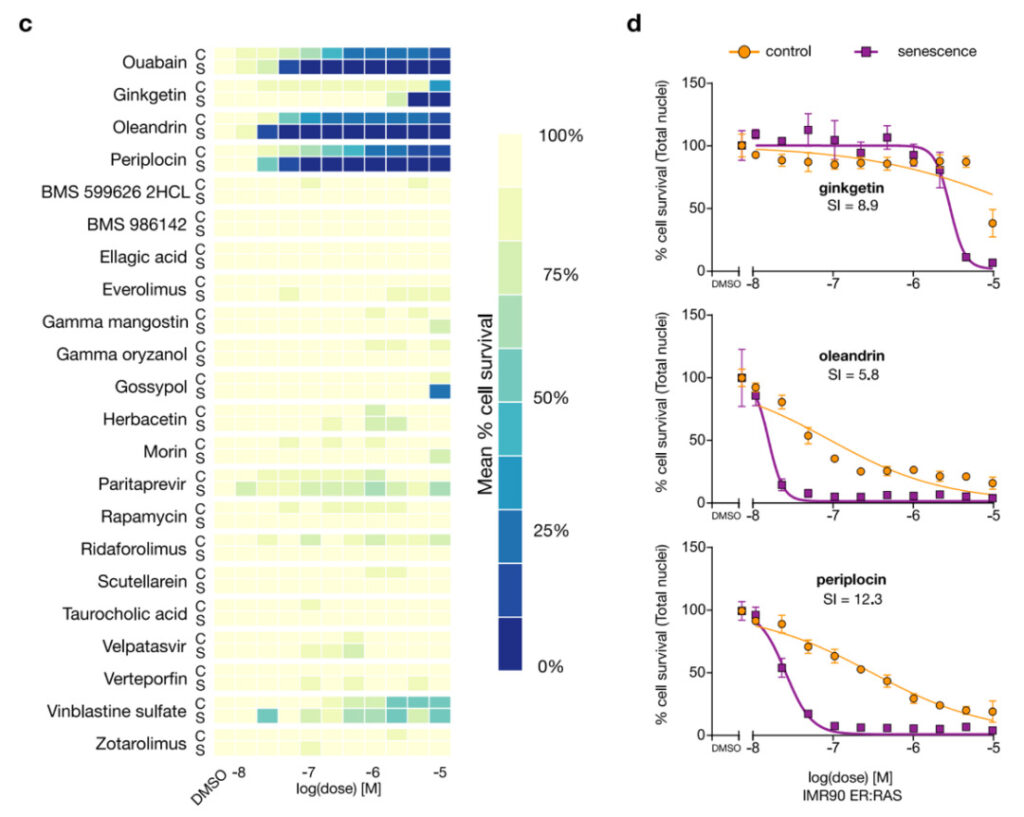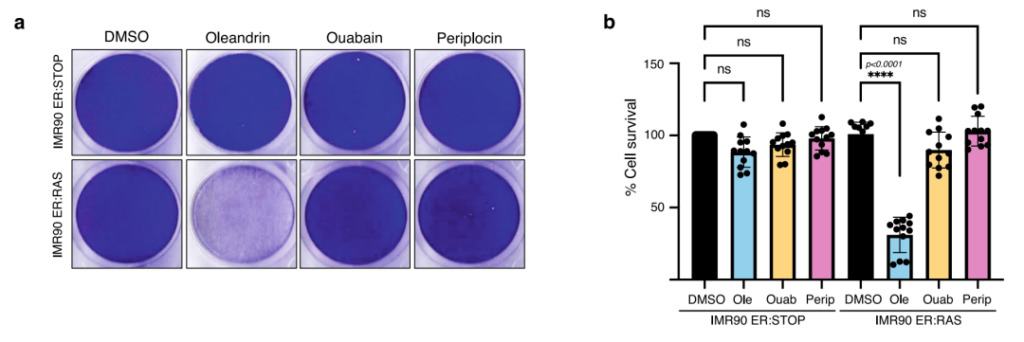To Prevent Cell Aging and Stay Away From age-related Diseases, the University of Edinburgh Has Issued Three "AI anti-aging Prescriptions" for Cells

Contents at a glance:Studies have shown that cellular senescence is closely related to diseases such as cancer, type 2 diabetes, osteoarthritis and viral infections. Although drugs to remove senescent cells have gradually become a hot topic in research and development, due to the lack of well-characterized molecular targets, few anti-aging compounds (Senolytics) have been discovered. Recently, a research result was published in the international journal Nature Communications, and researchers discovered 3 new Senolytics.
Keywords:Senolytics Machine Learning XGBoost
This article was first published on HyperAI WeChat public platform~
Since ancient times, people have been pursuing immortality. Surprisingly, in recent years, topics such as anti-aging and longevity are moving from the mysterious and illusory health care products industry to the medical and health industry recognized by the public. In general, aging is the process of slow weakening of body functions, and the process is irreversible, so humans can only let nature take its course and leave it to fate. However, what many people don't understand is thatAs early as 2018, the World Health Organization declared aging a treatable disease in the International Code of Diseases.
In the broad definition of aging, cellular senescence is one of the hot research directions of scientists recently. Cellular senescence is a phenomenon characterized by the cessation of cell division.Normally, the human immune system can effectively clear senescent cells, but as we age, this clearance function gradually weakens. In addition to causing worsening vision and limited mobility, it is also very likely to cause cancer, Alzheimer's disease and other diseases.
In 2015, Dr. James L. Kirkland and others from the Mayo Clinic discovered the first anti-aging drug (Senolytics) that can remove senescent cells.Senolytics refers to small molecule compounds that selectively induce senescent cell death. Its name is derived from Senescence (aging) and Lytic (destruction).In the latest study, the University of Edinburgh and the University of Cantabria used machine learning to discover three Senolytics - Ginkgetin, Periplocin and Oleandrin, and verified their anti-aging effects in human cell lines.The research has been published in the journal Nature Communications with the title “Discovery of Senolytics using machine learning”.

Figure 1: This research result has been published in Nature Communications
Paper address:
https://www.nature.com/articles/s41467-023-39120-1#Sec2
Experimental procedures
Dataset
The experimental datasets come from multiple channels, including academic publications and commercial patents.First, the researchers mined 58 known senolytics, and then mined a variety of non-senolytics from two existing chemical libraries, LOPAC-1280 and Prestwick FDA-approved-1280. The dataset combines the two.A total of 2,523 compounds were included, of which Senolytics accounted for 2.3%.

Figure 2: Compounds used to train machine learning models
a:The training data comes from multiple sources.
b:58 sources of senolytics used for training, including the number of compounds and cell lines for each source.
Model Training
The researchers used the above dataset to train a model to identify compounds with Senolytic (positive) characteristics. First, the researchers performed feature selection on the dataset.During this process, they used the random forest (RF) model to calculate the average Gini index reduction of each feature and selected the 165 most important features, thereby reducing the number of features and the complexity of the model.
- The Gini index measures the degree of confusion of samples in a node. The lower the value, the purer the samples in the node.
Second, the researchers developed multiple Senolytics binary classification models (identifying Senolytics or non-Senolytics) using the 165 most important features and various sample data from the full dataset.To compare the models and make full use of the limited number of Senolytics samples, the researchers performed 5-fold cross validation on the dataset and scored the models using three performance metrics: precision, recall, and F1 score.
Initially, researchers focused on support vector machines (SVM) and RF models, but experiments showed that their performance was not satisfactory.They also evaluated other models of different complexity, including logistic regressors, naïve Bayes classifier, and SMOTE, but the results showed that the performance of these models was not as good as SVM and RF models.
Therefore, the researchers developed an XGBoost model based on RF performance.Improve predictive power by iteratively training decision tree models.As shown in Fig. 3b, the XGBoost model has improved precision, recall, and F1 score, and performs the best among all the considered models.

Figure 3: Training a machine learning model
a:The model training, compound screening and result verification process uses multiple performance indicators to screen suitable models.
b:Performance of 3 machine learning models. The bar chart shows the average performance metrics calculated in 5-fold cross validation. The error bars represent one standard deviation.
The address of this experimental dataset will be synchronized to the HyperAI official website later:
https://doi.org/10.5281/zenodo.7870357
Experimental Results
First, the researchers screened 21 compounds from more than 4,340 compounds that may have anti-aging activity. Then, they tested these 21 compounds.As shown in Figure 4, three of them have the effect of clearing senescent cells: Periplocin and Oleandrin (two cardiac glycosides that have not yet been confirmed to be able to clear senescent cells) and Ginkgetin (a natural non-toxic biflavonoid compound).

Figure 4: Periplocin, Oleandrin and Ginkgetin Has the effect of clearing senescent cells
c:Experimental verification. Three of the 21 compounds showed anti-aging activity: Ginkgetin, Oleandrin and Periplocin; the heat map shows the mean of n = 3 repeated experiments. Ouabain is a known senolytic in the figure.
d:Dose-response curves of three newly discovered anti-aging compounds. SI is the anti-aging index.
In addition, during the above experiments,The researchers also found that the newly discovered Oleandrin had stronger anti-aging properties than Ouabain, especially at low concentrations.Therefore, the researchers compared the anti-aging activities of Periplocin, Oleandrin and Ouabain at a low concentration of 10 nM.

Figure 5: Periplocin, Oleandrin and Periplocin Comparison of anti-aging performance at low concentrations
a:The figure shows tissue culture dishes of IMR90 ER:RAS (senescent cells) and IMR90 ER:STOP (control) cells cultured in the presence of 100 nM 4OHT. Over the next 72 hours, cells were treated with 10 nM Oleandrin, Ouabain, and Periplocin, as well as DMSO (control).
b:Cell viability was assessed by quantitative analysis.
As shown in Figure 5b, low concentrations of Ouabain and Periplocin showed no significant cytotoxicity in IMR90-ER:STOP and IMR90-ER:RAS.After treatment with Oleandrin, the survival rate of senescent cells in IMR90-ER:RAS was significantly decreased, indicating that Oleandrin has a stronger anti-aging activity at lower drug concentrations.Based on the above experimental results,Machine learning can successfully find anti-aging compounds, and also found Oleandrin, which has stronger anti-aging effects than existing anti-aging compounds.
AI-driven drug discovery
AI plays an important role in all stages of new drug development. Currently, research focuses on drug discovery and preclinical development. This study demonstrates the potential of AI in drug development, especially when dealing with diseases with complex biological structures or few known molecular targets. Author Diego Oyarzún noted:“AI is very effective in helping us discover new drug candidates, especially in the early stages of drug discovery.”
Vanessa Smer-Barreto, the first author of the study, stressed the importance of close collaboration between data scientists, chemists and biologists. She said:"This work emerged from a close collaboration between data scientists, chemists, and biologists.We took advantage of this interdisciplinary collaboration to build robust models and save screening costs by using only published data for model training."This collaborative model provides new opportunities to accelerate the application of AI and is expected to drive innovation and development in drug research and development.
At present, although AI has made breakthroughs in new drug research and development, it still faces some challenges, such as data quality and reliability, algorithm interpretability, and model generalization ability.With the continuous advancement of technology and the increase of data resources, the application prospects of AI in drug research and development are still very broad.By strengthening data sharing and interdisciplinary collaboration, we can better utilize the advantages of AI, accelerate the discovery and development of new drugs, and bring benefits to human health.
Reference articles:
[1] http://zixun.69jk.cn/shwx/79532.html
[2]https://en.wikipedia.org/wiki/Cellular_senescence#Characteristics_of_senescent_cells
[3]https://newatlas.com/medical/machine-learning-algorithm-identifies-natural-anti-aging-chemicals/
[4]https://www.sohu.com/a/673349496_121124375
[5]https://www.ed.ac.uk/institute-genetics-cancer/news-and-events/news-2023/ai-algorithms-find-drugs-that-could-combat-ageing
[6]http://www.stcn.com/article/detail/904319.html
This article was first published on HyperAI WeChat public platform~